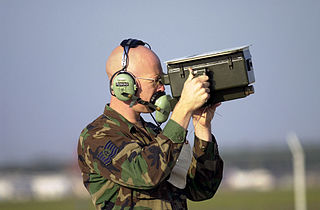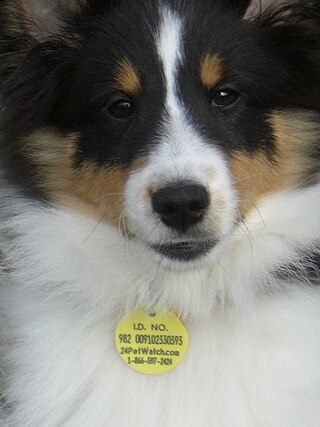Related Research Articles

In telecommunications, a transponder is a device that, upon receiving a signal, emits a different signal in response. The term is a blend of transmitter and responder.
Radio-frequency identification (RFID) uses electromagnetic fields to automatically identify and track tags attached to objects. An RFID system consists of a tiny radio transponder, a radio receiver and transmitter. When triggered by an electromagnetic interrogation pulse from a nearby RFID reader device, the tag transmits digital data, usually an identifying inventory number, back to the reader. This number can be used to track inventory goods.
ISO/IEC 14443Identification cards -- Contactless integrated circuit cards -- Proximity cards is an international standard that defines proximity cards used for identification, and the transmission protocols for communicating with it.

Identification, friend or foe (IFF) is an identification system designed for command and control. It uses a transponder that listens for an interrogation signal and then sends a response that identifies the broadcaster. IFF systems usually use radar frequencies, but other electromagnetic frequencies, radio or infrared, may be used. It enables military and civilian air traffic control interrogation systems to identify aircraft, vehicles or forces as friendly, as opposed to neutral or hostile, and to determine their bearing and range from the interrogator. IFF is used by both military and civilian aircraft. IFF was first developed during World War II, with the arrival of radar, and several friendly fire incidents.

The Electronic Product Code (EPC) is designed as a universal identifier that provides a unique identity for every physical object anywhere in the world, for all time. The EPC structure is defined in the EPCglobal Tag Data Standard, which is a freely available standard. The canonical representation of an EPC is a URI, namely the 'pure-identity URI' representation that is intended for use when referring to a specific physical object in communications about EPCs among information systems and business application software.

Digital Angel, Corp. is a developer and publisher of consumer applications and mobile games designed for tablets, smartphones and other mobile devices, as well as a distributor of two-way communications equipment in the U.K.

A microchip implant is an identifying integrated circuit placed under the skin of an animal. The chip, about the size of a large grain of rice, uses passive radio-frequency identification (RFID) technology, and is also known as a PIT tag. Standard pet microchips are typically 11–13 mm long and 2 mm in diameter.

The automatic identification system (AIS) is an automatic tracking system that uses transceivers on ships and is used by vessel traffic services (VTS). When satellites are used to receive AIS signatures, the term Satellite-AIS (S-AIS) is used. AIS information supplements marine radar, which continues to be the primary method of collision avoidance for water transport. Although technically and operationally distinct, the ADS-B system is analogous to AIS and performs a similar function for aircraft.
ISO 14223Radiofrequency identification of animals — Advanced transponders is an international standard that specifies the structure of the radio frequency (RF) code for advanced transponders for animals. The technical concept of advanced transponders for animal identification described is based upon the principle of radio frequency identification (RFID) and is an extension of the standards ISO 11784 and ISO 11785. This part of the standard describes the air interface between transceiver and advanced transponder.

An ear tag is a plastic or metal object used for identification of domestic livestock and other animals. If the ear tag uses Radio Frequency Identification Device (RFID) technology it is referred to as an electronic ear tag. Electronic ear tags conform to international standards ISO 11784 and ISO 11785 working at 134.2 kHz, as well as ISO/IEC 18000-6C operating in the UHF spectrum. There are other non-standard systems such as Destron working at 125 kHz. Although there are many shapes of ear tags, the main types in current use are as follows:
The National Animal Identification System, (naisG) is a government-run program in the United States intended to extend government animal health surveillance by identifying and tracking specific animals. Administered at the federal level by the Animal and Plant Health Inspection Service, a branch of the United States Department of Agriculture, NAIS will also be overseen by state animal health boards. While the federal program is voluntary, money received by some states, tribes, and non-profit entities from the USDA through cooperative agreements has been used to make parts or all of the program mandatory.

Transponder timing is a technique for measuring performance in sport events. A transponder working on a radio-frequency identification (RFID) basis is attached to the athlete and emits a unique code that is detected by radio receivers located at the strategic points in an event.
Real-time locating systems (RTLS), also known as real-time tracking systems, are used to automatically identify and track the location of objects or people in real time, usually within a building or other contained area. Wireless RTLS tags are attached to objects or worn by people, and in most RTLS, fixed reference points receive wireless signals from tags to determine their location. Examples of real-time locating systems include tracking automobiles through an assembly line, locating pallets of merchandise in a warehouse, or finding medical equipment in a hospital.

A pet recovery service is a service that has been created for the specific purpose of reuniting lost or stolen pets with their owners.
ISO/IEC 18000-3 is an international standard for passive RFID item level identification and describes the parameters for air interface communications at 13.56 MHz. The target markets for MODE 2 are in tagging systems for manufacturing, logistics, retail, transport and airline baggage. MODE 2 is especially suitable for high speed bulk conveyor fed applications.
A human microchip implant is any electronic device implanted subcutaneously (subdermally) usually via an injection. Examples include an identifying integrated circuit RFID device encased in silicate glass which is implanted in the body of a human being. This type of subdermal implant usually contains a unique ID number that can be linked to information contained in an external database, such as identity document, criminal record, medical history, medications, address book, and other potential uses.

Animal identification using a means of marking is a process done to identify and track specific animals. It is done for a variety of reasons including verification of ownership, biosecurity control, and tracking for research or agricultural purposes.
Chipless RFID tags are RFID tags that do not require a microchip in the transponder.
ISO/IEC 20248Automatic Identification and Data Capture Techniques – Data Structures – Digital Signature Meta Structure is an international standard specification under development by ISO/IEC JTC 1/SC 31/WG 2. This development is an extension of SANS 1368, which is the current published specification. ISO/IEC 20248 and SANS 1368 are equivalent standard specifications. SANS 1368 is a South African national standard developed by the South African Bureau of Standards.

The term digital card can refer to a physical item, such as a memory card on a camera, or, increasingly since 2017, to the digital content hosted as a virtual card or cloud card, as a digital virtual representation of a physical card. They share a common purpose: Identity Management, Credit card, Debit card or driver license. A non-physical digital card, unlike a Magnetic stripe card can emulate (imitate) any kind of card.